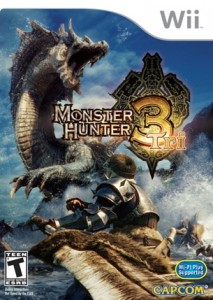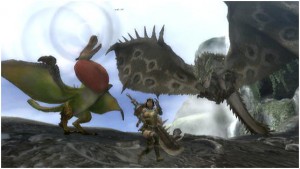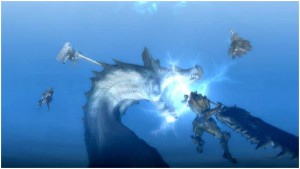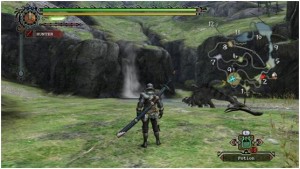Game Info:
System: Nintendo Wii
Category: RPG
Players: 1-2 (offline), 1-4 (over wi-fi)
Developer: Capcom
Publisher: Capcom
Monster Hunter Tri is the latest game in Capcom’s Monster Hunter franchise, a series of RPGs that have never really taken off outside of Japan. Well known for multiplayer co-op allowing for up to four adventurers to team up and take down colossal foes, the series now finds itself on the Wii —a system often criticised for its approach to online play. Is Tri the series’ best game to date or is there still something that has been lost in translation?
There’s really no plot to the game. In the single player mode, you’re a wannabe adventurer who is asked to save a small seaside village from a massive leviathan lurking in nearby waters. The storyline only really serves to add new gameplay elements, which is fine by me. After the first few tutorial missions, you can start opening up new missions courtesy of the Hunter’s Guild. Over time, more areas open up, and you can gain access to things like a farm providing you will common (but useful) items and ingredients, a shipping fleet offering to trade commodities and a cat-run canteen that serves up meals which grant temporary stat boosts and abilities. A few quests in, your lonely hunter is joined by Cha-Cha, this weird masked midget who serves as a constant companion both in and outside of quests. He can help gather resources, learn different techniques from different masks and, most importantly, act as a diversion for drawing monsters’ attention.
The quests in Monster Hunter Tri can be roughly divided into the hunting and gathering varieties. Hunting sends you off into an open area to seek out whatever monsters are on your “hit list.” Killing smaller beasts is fun —even if it does make me feel like a jerk— but the highlight of the game is the epic battles with the larger, more ferocious varieties of monster. From the water-spewing Royal Ludroth to the leechlike Gigginox, each monster has its own unique style of fighting, which is complemented by the well-programmed AI. Monsters will limp away from you when damaged, call upon smaller species for help and occasionally even square off against one another. The fights with “boss” monsters are often incredibly difficult, with attacks that can drain your health in a flash, but the difficulty is offset by the fact that you can “respawn” three times before failing the quest. The monsters are tough, but the difficulty never feels cheap, except for maybe when your hunter is hit in the middle of an overlong animation. Ultimately, fighting monsters is a lot of fun, which unfortunately can’t be said of the other variety of quests – gathering. Finding resources —everything from mushrooms to insects to bits of dead monster— is necessary to upgrade your equipment and make items, but running through the world obsessively collecting everything in sight doesn’t make for fun gameplay. Thankfully, the quests requiring you to collect inane items start to thin once you slay your first “real” monster, but those first few hours were some of the most excruciatingly dull I’ve endured in any game.
The thing I like most about Monster Hunter Tri is that it doesn’t encourage excessive grinding, something a lot of RPGs are guilty of. Sure, you might find yourself killing the same monster over and over to upgrade your equipment or doing the same quests online to increase your “hunter rank,” but success in Monster Hunter Tri is mostly based on skill. No matter how high your hunter rank or how good your armour set is, the large beasts you’ll square off against will make quick work of you if you don’t have a plan of attack or can’t wrap your head around the controls.
Each weapon features a different control scheme and suits different styles of play. There’s a sword and shield combo and great sword are good for beginner players, as they’re relatively simple to wield, but other weapons like the lance (very defensive but sluggish) and the hammer (powerful but leaves you wide open for attack) require a bit of strategy to put them to good use. More weapons like the new switch axe and the long sword are unlocked through beating single player quests. The only ranged weapon is the bowgun, but the fact that you can mix and match various frames, stocks and barrels to craft them makes them very versatile. They can also fire around 40 types of ammo —everything from elemental bullets to tranquilisers. Weapons can As I mentioned before, each weapon has its own control scheme, and they’re all fairly intuitive, provided you’re playing with a classic controller. Shaking the Wii remote to use your weapon gets tiring after a quest or two, and using the D-pad to move the camera simply doesn’t work in an action-centric game like Monster Hunter. If you can, go for the Classic Controller Pro bundle, as it feels a lot more comfortable and doesn’t make you look like an idiot. Regardless of the controller, using your weapon still feels incredibly slow and clunky, due in part to the lack of any “lock-on” system. It took me a fair bit of practice to actually hit something with my weapon, and even then I kept being hit during my attack animations. The difficulty curve for mastering weapons is pretty steep, but not impossible if you’re the dedicated type.
Tri’s underwater environments are a first for the Monster Hunter series, and —going against all tradition for water levels— don’t suck. Moving the camera around underwater takes a bit of getting used to as it also controls the direction your character moves in, but swimming around is quick and mostly painless (unless you happen to swim into the fearsome Lagiacrus featured on the game’s cover). Apparently monster hunters can hold their breath for ridiculous amounts of time, which makes things easier, not to mention the fact that weapons and items used underwater work almost exactly as they would on land. Yes, even the bowgun. The underwater sections really open up the exploration and allow for a lot more interesting environments and monsters.
Online play is being touted as one of the game’s main draws but I couldn’t help but feel a bit underwhelmed by it. On my first visit to the online city, I was greeted with a nice looking cinematic showing a bustling metropolis full of hopeful hunters interacting with each other. In reality, online play is limited to small rooms allowing only a maximum of four players at a time. The lack of a central “hub” area means there’s a lot of jumping between rooms before settling into a group that actually wants to hunt with you. Expect to see quite a few loading screens. That said, it’s still one of the most ambitious online experiences on the Wii, due in part to the fact that there’s not a friend codes in sight. You’ll still need to register strangers if you want to chat over Wii Speak, but the game also supports USB keyboards for when the action gets too fast paced to use the awkward on-screen keyboard. Most of the online quests (at least the early ones) are nearly identical to the offline ones, with a slight increase in difficulty to balance the addition of more players. Even with a few companions by your side, mundane tasks like fishing and gathering resources aren’t much more exciting, but the big draw of online play is Event Quests. The game is updated fairly regularly with additional quests, often with the reward of rare weapons and armour (shark-shaped lance, anyone?).
Offline multiplayer is limited to Arena Mode, which is basically a split-screen “time attack” mode pitting you and a friend against a monster. It’s worth mentioning because it allows you to use the Wii remote to store your character’s information, use it on a friend’s Wii, and then transfer any rewards from the arena back to your own console. It’s a neat feature, and something more games on the system should take advantage of.
Monster Hunter Tri is easily one of the best looking games on the console. The picturesque landscapes and detailed monsters look good even compared to games on high-definition systems, but there are a few things like character clipping and pop-in that constantly remind me of the Wii’s hardware limitations. The nice graphics also come with a lot of loading screens. The load times are fairly short, but considering each tiny area comes with its own load screen, you’ll be seeing them a lot. Monster Hunter Tri’s soundtrack is also a highlight. You won’t hear it a lot while questing, but once a big monster draws near, the epic orchestral pieces start to really crank up the tension.
As Austin explained in one of his lastest features, Monster Hunter Tri has plenty of flaws, but the whole game comes together remarkably well. The frustrating controls, often dull quests and difficult battles will likely put a few players off, but the game is worth sticking with because of its atmosphere, aesthetics and the fun of taking down a massive monster with a few friends. Even if you don’t have a wireless internet connection, the single player mode has more than enough content to keep you busy for weeks. Monster Hunter Tri is as ambitious as it is addictive, and if you can look past its shortcomings, is a fine example of how to make an enjoyable action-RPG for the Wii.
Overall score: 9/10



